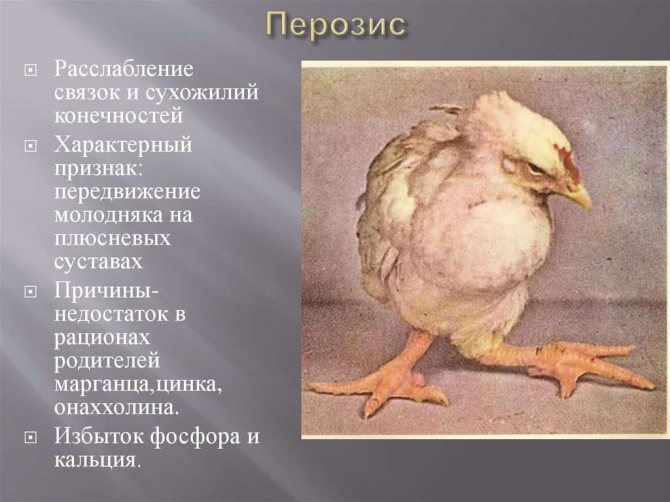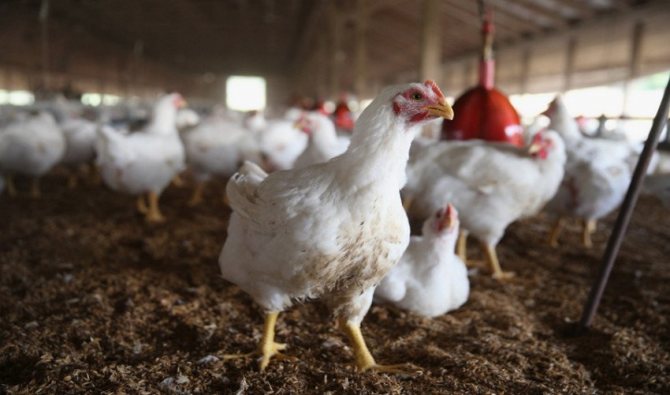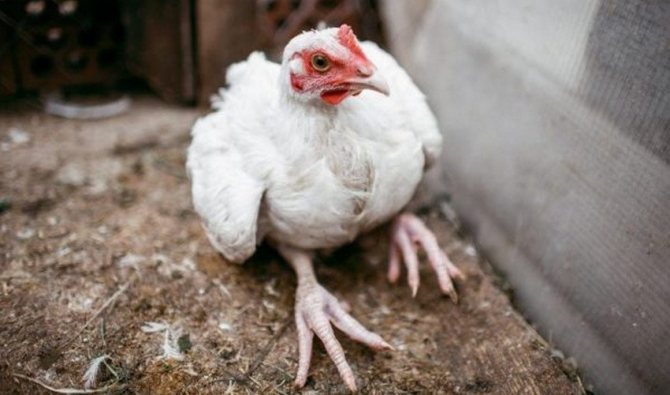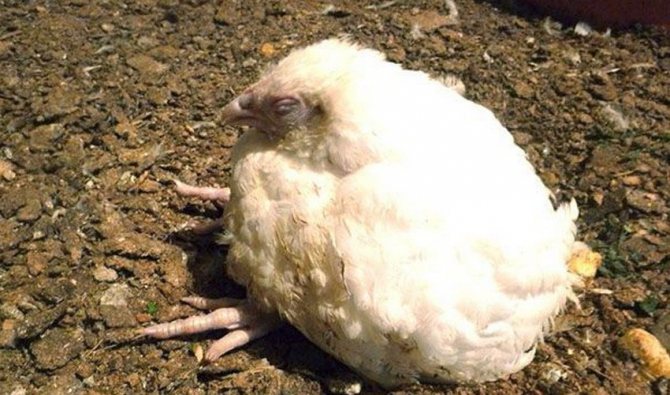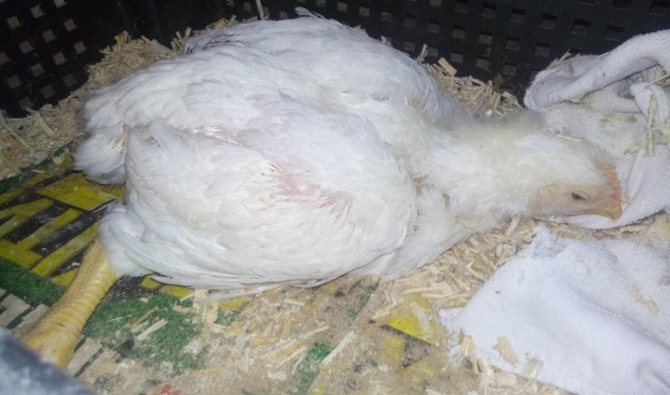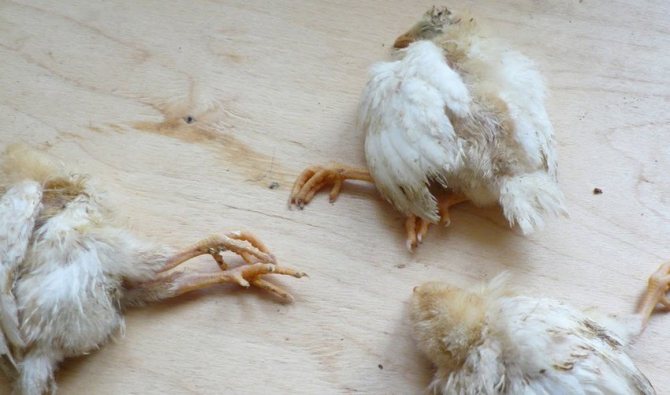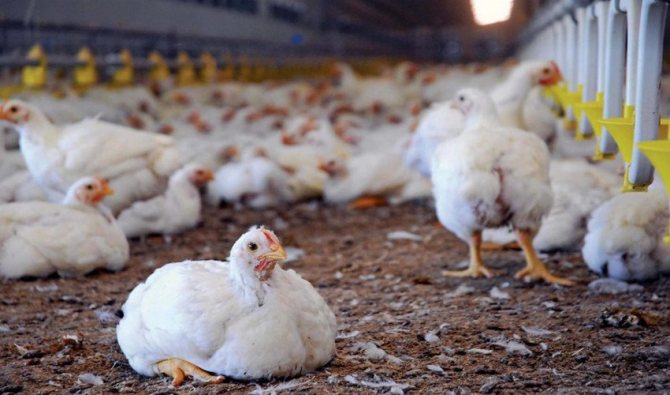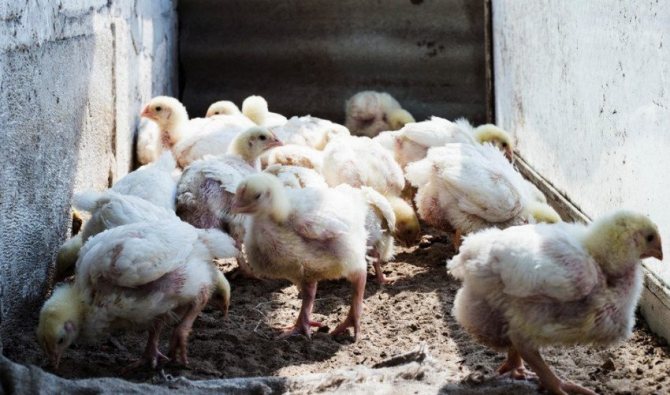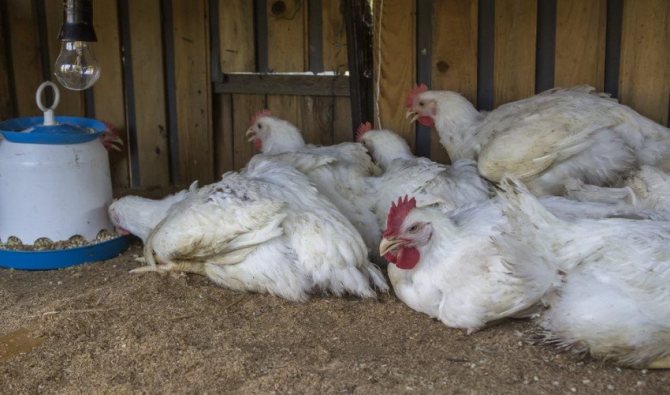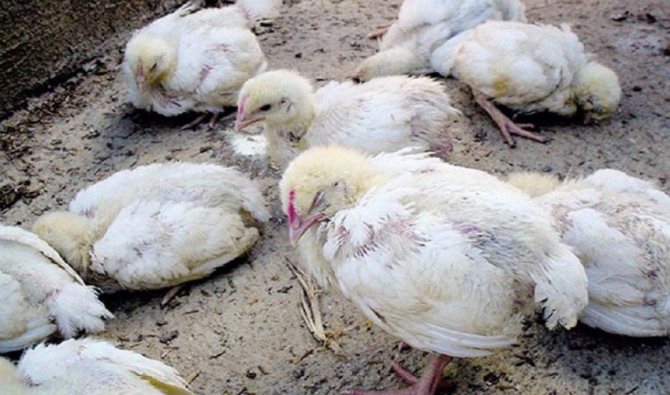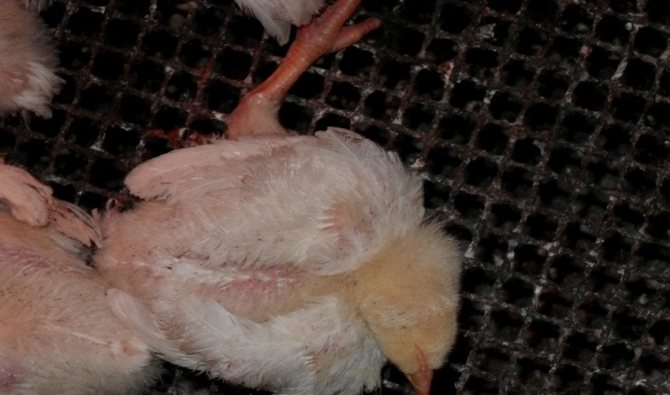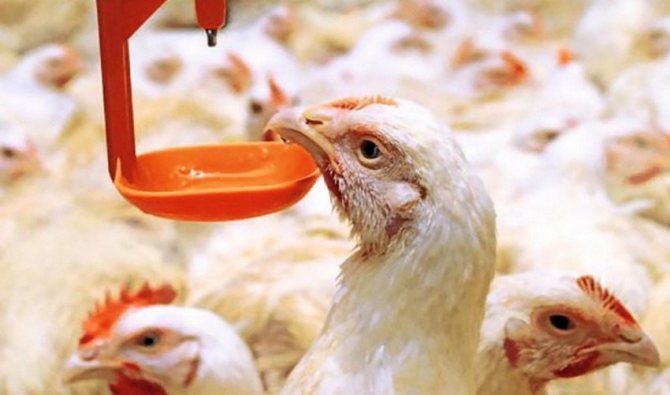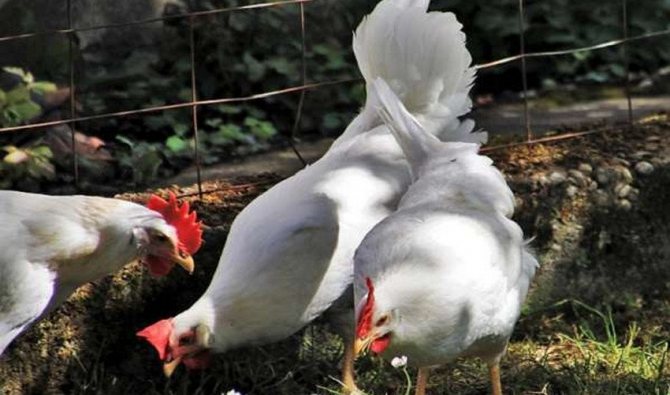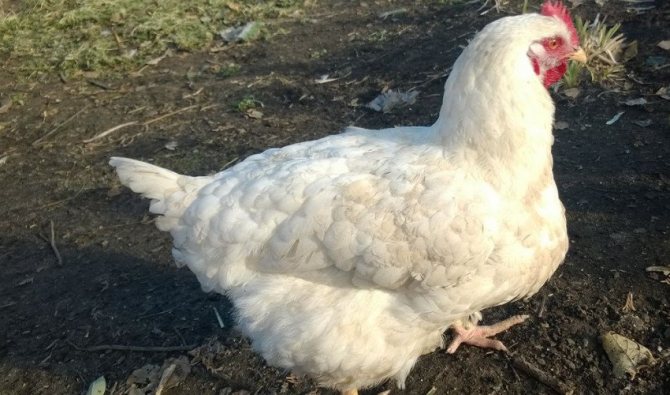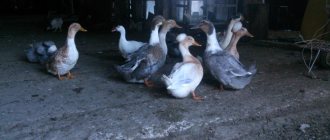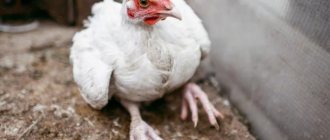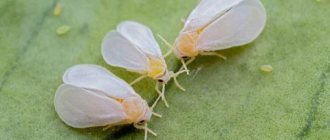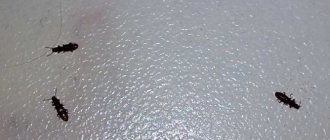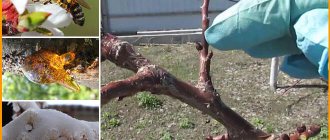The broiler chicken breed is considered the best meat breed for breeding in backyards and on an industrial scale. But often most novice poultry farmers are faced with the problem of broilers falling to their feet.
At the same time, if measures are not taken in time, then the livestock may die. Below we will consider all the reasons why such a nuisance can overtake a broiler cross, how to overcome such a problem, and what should be done as a preventive measure.
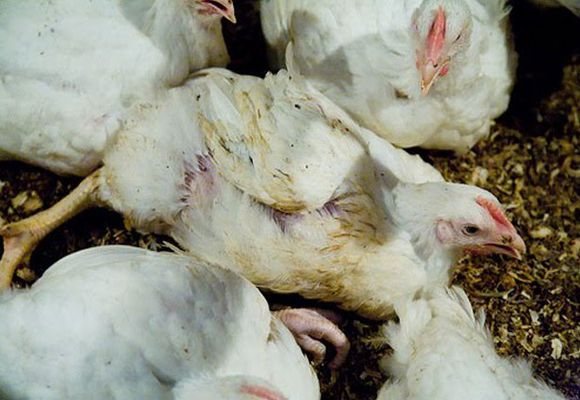
Improper and proper nutrition
A balanced menu is the basis for the development of a healthy individual. Farmers make a common mistake and feed the herd exclusively with compound feed. For the formation of the body, not only grain is needed, but also greens. You can add raw and boiled vegetables to the diet:
- beets;
- cabbage;
- carrot.
From the age of five, chickens are offered veterinary preparations containing vitamins A, D, E. They are mixed with feed or they are forced to drink or drip into the mouth of the chicks. Sprouted grains and greens are excellent natural sources of micronutrients.
Improper nutrition is the reason why broilers sit on their feet. Layers need a lot of nutrients, so they add to the menu:
- bone meal;
- seashells;
- a piece of chalk;
- salt.
Professional veterinary drugs are available in liquid form and are easy to mix with food. They are responsible for the normal state of the body of birds and do not allow disease to develop. Remember that an excess of trace elements is just as harmful as a deficiency, so all procedures are carried out according to the instructions.
Tenosynovitis, arthritis
Arthritis - the disease is manifested by inflammation of the joint capsules. The disease can occur in birds of any age. And tendovaginitis is manifested by inflammation of the tendons. Broiler breeds are usually at risk due to their rapid growth.
Oftentimes, arthritis is caused by poor nutrition, a virus, or poor hygiene. With regular sanitization, such diseases are not terrible.
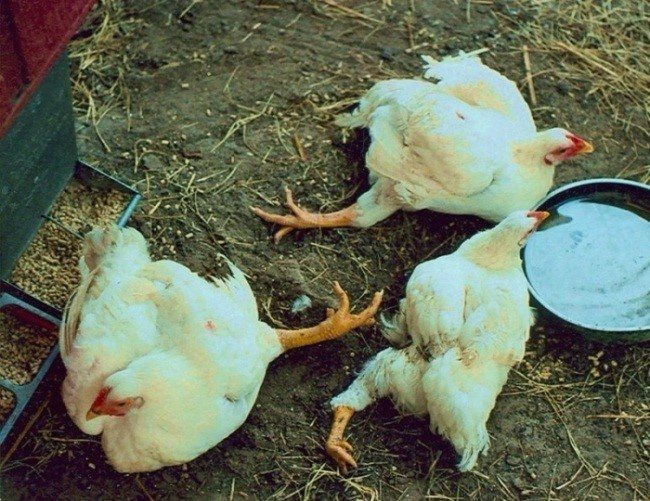

Incorrect containment conditions
A sedentary lifestyle and limited space cause adult broilers to fall to their feet. According to the standards, no more than five broiler chickens or ten chickens can be marked on one square meter. The crowded content leads to the fact that diseases begin in the herd.
Ignoring hygiene rules is another reason the problem arises. Dirty paws ailment finds a good environment for development in an unkempt chicken coop. In diseased individuals, the joints visually increase and the temperature in the affected organ rises. If you do not start to treat birds in time, you can notice how their paws are moving apart and sick individuals sleep more.
Excessive sterility is bad for the health of the livestock. In utility rooms, beneficial bacteria are destroyed, as a result of which the natural microflora is disrupted and immunity suffers. broiler chickens lose their appetite and cannot stand on their feet, they simply leave.
Improper housekeeping also causes leg problems.If the broiler falls to its feet, urgently need to take emergency measures. In addition to ultraviolet radiation, the chicken coop should have optimal living conditions. Heat or cold affects the health of the herd, and lack of fresh air leads to illness. Excess moisture also becomes the source of many troubles.
Bird injury
If a laying hen or rooster sits on its paws, then this may not always be the cause of any internal problems. Often the bird steps on a nail or glass, resulting in a cut. Mechanical damage begins to hurt and fester, so the chickens stand still and sink to the ground. If this happens, you need to examine the bird and be sure to contact your veterinarian.
High perches can also provoke limb ailments, so broilers often fall to their feet, this reason should be eliminated as soon as possible. According to the rules of maintenance, perches cannot be installed at a level more than 90 cm from the floor. A careless laying hen or a heavy broiler will jump off, and the result will be a fracture, dislocation. As a result, the chicken sits on its feet. If a feathered pet falls from its roost, immediately provide first aid and show it to a specialist.
Before starting treatment, you need to carefully examine the paws, feel each joint. If the limbs are swollen and redness appears, then this may indicate the presence of an injury or fracture. Wounds on the skin, especially in the area of the fingers, are invisible at first glance, so everything must be checked carefully.
Arthritis
This is an unpleasant disease that occurs in both adult domestic individuals and young animals. Inflammatory processes in the joint capsules and adjacent soft tissues lead to the fact that the birds limp and fall on their paws. If the disease is not treated, the affected limbs will fail.
Sometimes the disease manifests itself as tendon inflammation. Tendovaginitis is most common in older individuals, while arthritis is characteristic of the young. The combination of the wrong content from the virus that has entered the body finds a favorable environment for the disease. Keep an eye on the inhabitants of the chicken coop, no matter how old they are, and they will always be healthy.
Compliance with hygiene standards in the hen house excludes the occurrence of a dangerous ailment. The affected individual has constrained movements, and because of the pain syndrome, she cannot sit on the perch and walk normally. Enlarged hot joints are the main symptoms of ailments. If the birds are not treated, they will soon die.
Small chickens of an early age: from a few days to a month, they can also be susceptible to this disease, and a veterinarian can tell you how to cure it.
Marek's disease
Infectious paralysis or neurolymphotosis is a very dangerous disease. The virus infects the nervous system and eyes of chickens. Additionally, tumors are formed on the bones, organs and on the skin. In infected individuals, the motor functions of broilers are impaired; broilers are constantly falling and injured.
Those who are sick have a loss of appetite, as a result of which they are quickly depleted. The iris changes and the pupil narrows. The growths on the head turn pale, become colorless. All transport functions are weakened and the broiler collapses.
In the last stage, the disease deprives the crested eyesight. She stands with her wings down or rolls over on her side. More often than not, infected broilers die. The disease is dangerous in that it is an infection and can quickly spread throughout the livestock. Within a short period of time - a month, an inexperienced farmer will lose the entire herd.
Rickets
The cause of the disease is vitamin D deficiency. Usually, young individuals are at risk, although the disease can also affect mature birds. The main manifestation is the violation of calcium-phosphorus metabolism.If we are talking about adult birds, then often the ailment is manifested by decalcification of the bones or violation of the egg shell. In addition to a lack of vitamin, its manifestation can be affected by the lack of sunlight. After all, as you know, this element is capable of being produced independently under the influence of sunlight. Therefore, experienced professionals always try to keep birds in free enclosures, rather than cramped cages.
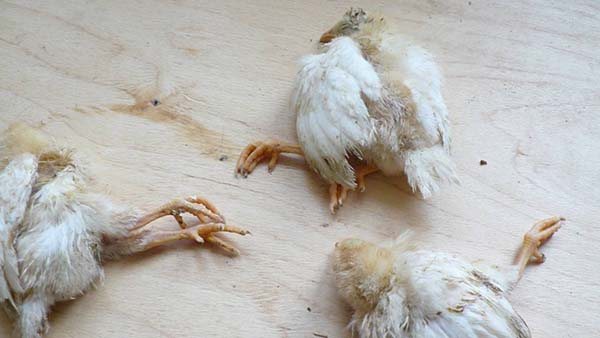

The first suspicious symptoms are usually loss of appetite, weakness, and little activity of the pet. If you do not start treatment within a month, the consequences can be serious. If the chicken's paws have failed, it means that the last stage of the disease has come. It is often impossible to cure a sick bird. A similar outcome occurs when the situation is running.
But you can notice the disease in large chickens by weakening the shell of their eggs, chromate, weakness when moving, and a decrease in egg-laying.
Broiler life
Meat breeds of birds are distinguished by an increased appetite, therefore they grow very quickly. If broiler chicks fall to their feet, it is difficult to regain motor function. Treatment should be carried out immediately and not wait for the manifestation of other symptoms, monthly chickens are the worst treated.
Broiler chickens most often suffer from breach of keeping technology. Unlike egg breeds, they react painfully to a lack of vitamins A, D, E and calcium deficiency. Often the livestock is grown in closed pens, so there is not enough UV radiation, so everything must be done to avoid problems.
The crowded content of broiler chickens also negatively affects the immunity of the young. Chicks react painfully to excess moisture and low temperatures in the chicken coop. In addition to all of the above, excess weight becomes the cause of the problem. To prevent chicks from becoming fat and sedentary and painful, keep them in a more comfortable environment.
Treatment of diseases
What if the chickens sit down or limp? The first step is to isolate diseased individuals from a week to a month. Such a measure will exclude the possibility of transmission of infection to healthy livestock. Additionally, you will protect patients from the aggression of relatives.
We recommend that you carefully examine the fallen bird in order to try to find out the cause of the disease. If there are negative signs (legs are parted, a soft beak, and other signs), then you need to go to the veterinarian. The doctor will tell you what to do and what medications to take in your case. Self-treatment without prescriptions can have dangerous consequences.
If the chicken has sat down due to the wrong diet, then we recommend that you immediately revise the menu. It is necessary to give daily both grain and a soft mash of vegetables. Be sure to include grass in summer, and sprouted grains in winter. Veterinary vitamin preparations are inexpensive, but they help keep the livestock healthy.
Doctors recommend using tricalcium phosphate to get rid of problems with joints and limbs.
Antibiotics are used to combat arthritis and tendovaginitis. Within five days, the agent is administered intramuscularly or added to food. In case of injuries and dislocations of the tendons, we recommend introducing more manganese and B vitamins into the diet. If there are wounds on the extremities, then it is necessary to treat the affected areas and isolate the patient.
To treat infections, specialists use antibiotics and antiviral agents. The professional prescribes medication by intramuscular injection or as a feed additive. The procedure is repeated for five days, after which the veterinarian is visited again.
If Marek's disease is diagnosed, then the diseased individual is killed. Dangerous ailment cannot be cured, so the source must be destroyed. Remember that the virus is very tenacious and remains in feather follicles.The only way to avoid the disease will be vaccination of young animals. The body of adult birds does not respond to vaccination.
Perosis
The people call this disease - tendon displacement. It usually occurs in broilers due to rapid development. The cause is malnutrition, vitamin deficiency. Usually begins to manifest as an unnatural curvature of the limbs. As a result, the chicken's paws hurt a lot, it stops walking. Treatment is often considered irrational.
Sometimes chicks have sore legs due to completely different reasons. It is worth exploring them as well:
- Tightness. You need to purchase chickens based on the size of the room. Usually, 1 square meter for 4 individuals is considered the norm. A high planting density can prevent them from developing normally, and worsen their health.
- Wounds, cuts. Often, while walking, birds are injured from glasses and nails. After that, an infection develops in the wound. To avoid this, it is necessary to control the cleanliness of the walk. There should be no foreign objects here.
- High perch height. The chicken can easily jump off it and fall, having received a pearl. So it's worth editing its height well. The ideal parameters are considered to be 60-90 centimeters from the floor.
Preventive measures
In order to prevent problems from arising, it is better to prepare for them in advance. Taking precautions can not only get you out of trouble, but it can also save your flock. We recommend revising the diet and adding components necessary for broilers. Proper nutrition from childhood is the key to the health of adults.
If the culprit of the disease is a violation of the content, then the problem must be eliminated immediately. Remember that the metabolic processes in the bird's body are very fast. Ignoring the requirements will lead to the death of the entire herd.
Egg chicken breeds need a lot of living space. If there is movement, then obesity can be avoided. Crowding is always dangerous: due to the close content, viruses quickly spread throughout the chicken coop, which causes massive deaths.
Prophylaxis
To prevent the development of various infections, the livestock is vaccinated. Vaccinations are given in the first month of the chicks' life. Sometimes antibiotics are given to individuals as part of preventive measures. For such purposes, the following drugs are used:
- Baycox.
- Metronidazole.
- Baytril.
Since the immunity of chicks suffers under the wrong conditions of keeping, experts recommend timely disinfecting any equipment with which the livestock comes into contact. It is necessary to clean the feeders, drinkers, cages from contamination. Use only disposable syringes for injections.
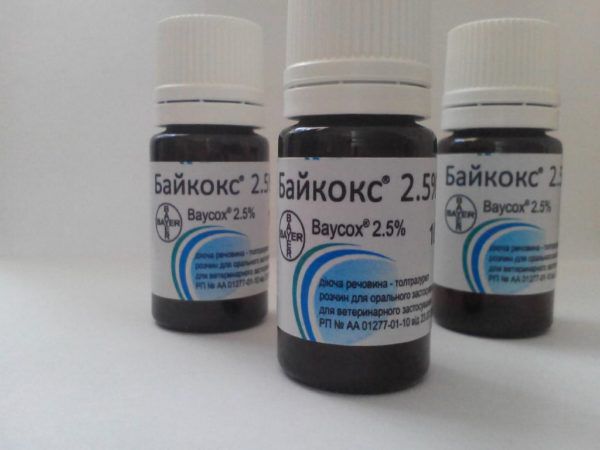

Baycox drug
Table 2. How to make a vaccine for a chicken: step by step instructions
| Illustration | Description |
| Step one: draw the vaccine into a pipette or syringe without a needle. | |
| Step two: gently but firmly hold the chicken in your hand, asking the second person to hold the bird's head. | |
| Step three: squeeze out the right amount of vaccine (according to the instructions). The most painless is the injection of the vaccine by the method without a puncture, but by injecting the liquid into the eyes or nose. |
A few days before settling the young, it is necessary to process the poultry house. Bleach is considered the most effective disinfectant. This will protect the chicks from various pathologies.
To prevent the development of diseases of the musculoskeletal system, you should adhere to the following preventive recommendations:
- Provide the grown chickens with daily walking. For such purposes, a spacious aviary is being built.
- For birds of meat breeds, low perches are installed, about 50-60 cm from the floor level. Otherwise, the likelihood of falling individuals is not excluded.
- Pounded eggshells, wood ash and shells are added to the food.
- In winter, for adult chickens, it will be necessary to maintain a temperature in the house of at least 20-21 degrees.For comfortable keeping of the growing young stock, a temperature of about 25-27 degrees is required.
Provide adequate ventilation in the house. The accumulation of hydrogen sulfide in the air negatively affects the well-being of chickens.
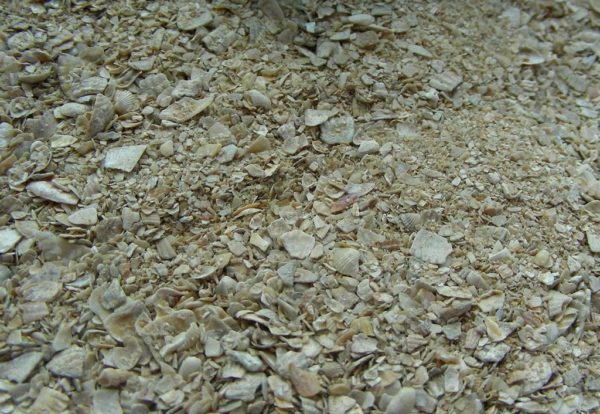

Shredded fodder shell
Housekeeping is the key to bird health
What should be done to prevent the bird from getting sick? The room in which the birds live must be ventilated daily and the garbage must be removed regularly. Meat breeds often live in cages, so we recommend that you spare no expense and purchase ultraviolet equipment. Irradiation once a day will prevent falling on the paws. They also increase daylight hours to 12 hours.
To prevent the birds from contracting the dangerous Marek's disease, they acquire young and adults in proven farms. All newcomers are first sent to quarantine, and only then are added to the main herd. Vaccination will eliminate possible problems.
Diseases in chickens proceed rapidly and if you do not pay attention to the symptoms, then you can lose all the livestock. Our recommendations will help you find the cause of chicks falling on their feet. It is better to entrust treatment to professional veterinarians.
Now you know why broiler chickens fall to their feet and how to prevent broilers from falling on their legs and wings. If you do not have enough information, you can watch a video on the topic: How to do if broilers fall, how to cure them at home and how to help them?
How to treat?
Now every owner is aware of what usually causes the weakening of the legs of birds. Most often, the wrong diet is to blame. It is necessary to revise it sooner, balance it, add vitamins. However, if the situation does not improve, you should seek help from a specialist. After a thorough examination, the doctor will be able to prescribe the correct treatment. Usually it consists in the use of special medications.
To exclude a massive decline, it is recommended at the first symptoms to retire a sick bird from everyone. In isolation, it is worth taking up treatment.
Chick care rules
Distinctive features of a painless chick:
- holds firmly on its legs;
- moves briskly;
- responds to light and sounds;
- pecking reflex is formed;
- soft neat belly;
- tightened umbilical cord;
- clean cesspool;
- shiny sloping eyes;
- wings tightly pressed to the body.
Vulnerability is typical for chickens in the first days and weeks of life. If the chicks die, a lot of care is required. During this period, emphasis is placed on:
- maintaining optimal temperature;
- quality feeding;
- abundance of water;
- provision of conditions of detention.
Note! Chicks from the incubator are placed under a hen or in a cardboard box, which is placed in a dry and warm place. In such a box, babies have more chances of adaptation, heating and strengthening.
The diet
Correct feeding is the basis for raising chickens. High-quality food and a rational diet will allow you to grow a healthy livestock.
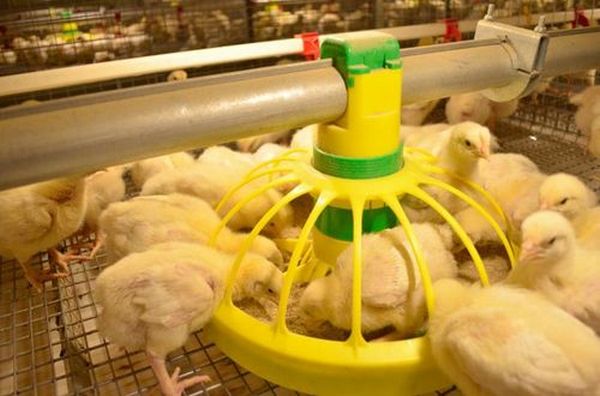

Special nutrition for chickens
Experts advise sticking to the following menu:
- 1 day. They feed after about 8 hours, as the chicks hatched. Pour low-fat cottage cheese, millet, chopped yolk, sprinkled with semolina. They do not give compound feed, mash.
- 2nd day. Stir in whey or yogurt. Frequent feeding (after 3 hours), but in small portions. Boiled water is poured into drinking bowls.
- Day 5. In the summer they walk in the yard. Greens have a beneficial effect on the digestive system: clover, nettles, pre-scalded and chopped, green onions, chopped carrots. In winter, they give dried grass.
- Day 10. Differences between broilers and layers. Broiler chickens are offered compound feed in 2.5 hours. Egg-type chickens are fed mainly cereals at 3-hour intervals.The food includes a mixture of cereals that are boiled in low-fat milk or water. It is appreciated that the chicks receive calcium, which is required for the structure of the skeleton.
- 3 week. The feed is enriched with vitamin and mineral supplements. Establish an alternation of dry food and mash meals. In the summer, when the chickens are walked in the daytime, the amount of food is reduced. In the evening, they get by with full portions. Leave the grain at night.
- 1 month. Transfer of chickens to the feed of the same name. Clear feeding hours, grain is not crushed, the ration contains ordinary feed.
On a note! When feeding chicks, keep the feed containers clean.
Dry feeders are suitable for bulk products that leave for a long time. The bird is given only a fresh mash. To prevent food leftovers from souring, they are removed after 40 minutes. The feeder is definitely washed. Clean water is given daily.
Poultry house
When keeping chickens, they adhere to the rules:
- Clean room.Cleaning up uneaten food and garbage - sources of infectious diseases.
- Periodic bedding change.
- Freedom of space. The birds must move, their motor functions are not completely limited.
- The number of livestock. The area and number of chicks are interdependent.
Shine
The length of daylight hours depends on the age of the chicks. When chicks hatch, it is at least 18 hours. By the 4th month, the indicator gradually decreases and reaches 10 hours. The parameter is not affected by the breed of chickens. In winter, additional lighting is used.
Temperature regime
The age of the birds also affects the temperature in the barn:
- + 32 ° С - the ideal temperature for five-day-old individuals;
- + 28 ° С - suitable for chickens that are 6-9 days old;
- + 25 ° С - this is the temperature for 10-day-old babies;
- + 20 ... + 24 ° С - temperature regime in the future.
Advice! Maintain optimal temperature thanks to lighting lamps. Installation of a heater is advisable during the winter season.
About leg diseases in chickens (symptoms)



